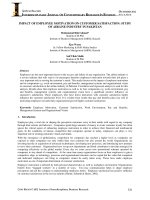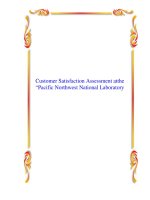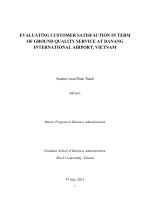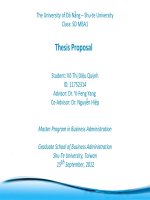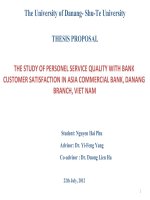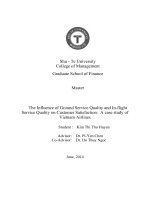customer satisfaction assessment on vietnambanks card service quality
Bạn đang xem bản rút gọn của tài liệu. Xem và tải ngay bản đầy đủ của tài liệu tại đây (1.05 MB, 80 trang )
VIETNAM NATIONAL UNIVERSITY, HA NOI
SCHOOL OF BUSINESS
DO THI THEM NGOC
CUSTOMER SATISFACTION ASSESSMENT
ON VIETINBANK’S CARD SERVICE QUALITY
Major : Business Administration
Code : 60 34 05
Master of business administration thesis
Supervisor: VU ANH DUNG, PhD.
HA NGUYEN, MBA.
Hà Nội 11/2011
TABLE OF CONTENTS
ACKOWLEDGEMENT ............................................................................................ i
LIST OF TABLES .................................................................................................. vii
LIST OF FIGURES ............................................................................................... viii
INTRODUCTION ......................................................................................................1
CHAPTER 1 - CONCEPTUAL FRAMEWORK ...................................................5
1.1. Service quality ..................................................................................................5
1.1.1. Service definition .......................................................................................5
1.1.2. Quality definition .......................................................................................7
1.1.3. Service quality ...........................................................................................8
1.1.4. Bank card service quality.........................................................................11
1.2. Measurement of service quality ...................................................................12
1.2.1. Review of multi- attribute concept ..........................................................12
1.2.2. Review of Nordic Model .........................................................................13
1.2.3. Review of Servqual model.......................................................................14
1.2.4. Review of Servperf model .......................................................................17
1.2.5. Review of Kano model ............................................................................19
1.3. Suggested model.............................................................................................23
1.4. Previous research...........................................................................................24
1.4.1. Previous research outside Vietnam ..........................................................24
1.4.2. Previous research in Vietnam ..................................................................29
CHAPTER 2- RESEARCH METHODOLOGY ..................................................31
AND OVERVIEW ON VIETBANK ......................................................................31
2.1. Research methodology ..................................................................................31
2.1.1. Research design ............................................................................................31
v
2.1.2. Sample design ...............................................................................................35
2.1.3. Data collection ..............................................................................................36
2.1.4. Data processing ............................................................................................37
2.2. Overview on Vietinbank’s card service .......................................................38
2.2.1. Overview on VietinBank .........................................................................38
2.2.2. Overview on Vietinbank card business activities ....................................40
CHAPTER 3: FINDINGS AND ANALYSIS ........................................................46
3.1..Characteristics of the sample ...................................................................46
3.2.Customer satisfaction on Vietinbank’s card ...........................................49
3.3. Comparison between customers’ satisfaction toward each service
attribute and the overall satisfaction level ....................................................54
3.4. Comparison of Vietinbank’s and other banks’ card service quality ...58
CHAPTER 4- CONCLUSIONS AND RECOMMENDATIONS ........................64
CHAPTER 4- CONCLUSIONS AND RECOMMENDATIONS ........................64
4.1. Conclusions ....................................................................................................64
4.2. Recommendations..........................................................................................64
4.2.1. Suggestions to improving debit card service quality...............................65
4.2.2. Suggestions for Vietinbank to improving credit card service quality ...67
4.2.3. Suggested action plan for Vietinbank to improve card service quality
in the next two years .............................................................................................68
REFERENCES .........................................................................................................69
APPENDICES ..........................................................................................................72
Appendix 2: Data from survey ................................................................................73
Q 2: Gender of respondents ....................................................................................73
vi
LIST OF TABLES
TABLE 1.1- SERVICE ATTRIBUTES .......................................................................................................... 10
TABLE 1.2- SERVICE ATTRIBUTES .......................................................................................................... 11
TABLE 2.1- MEASUREMENTS OF INDICATORS ..................................................................................... 33
TABLE 2.2- VIETINBANK’S CARD ............................................................................................................ 41
TABLE 3.1- CUSTOMER SATISFACTION ON VIETINBANK’S CARD SERVICE QUALITY ............. 54
TABLE 3.2- CUSTOMER PERCEPTION OF VIETINBANK’S CARD SERVICE ..................................... 60
TABLE 4.1- SUGGESTED ACTION PLAN FOR 2012 AND 2013 ............................................................. 68
vii
LIST OF FIGURES
FIGURE 1.1: THE KANO DIAGRAM ........................................................................................................... 21
FIGURE 2.1- DEBIT CARD MARKET SHARE IN 2010 ............................................................................. 40
FIGURE 2.2- MARKET SHARE OF INTERNATIONAL CARD IN VIETNAM, 2010 .............................. 42
FIGURE 2.3- BANKS’ POINT OF SALE IN VIETNAM, 2010 .................................................................... 44
FIGURE 2.4- REVENUE OF INTERNATIONAL CARDS IN VIETNAM, 2010 ........................................ 44
FIGURE 3.1- AGE OF RESPONDENTS ....................................................................................................... 46
FIGURE 3.2- GENDER OF RESPONDENTS ............................................................................................... 46
FIGURE 3.3- WORKING FIELD OF RESPONDENTS ................................................................................ 47
FIGURE 3.4- RESPONDENTS’ USE OF BANK CARD .............................................................................. 48
FIGURE 3.5- DECISIVE FACTORS TO CHOOSE BANK CARD SERVICE ............................................. 49
FIGURE 3.6- USE OF BANK CARD SERVICE ........................................................................................... 49
FIGURE 3.7- CUSTOMER SATISFACTION ON VIETINBANK CARD SERVICE RANKING BY
SATISFACTION LEVEL ..................................................................................................................... 51
FIGURE 3.8- CUSTOMER SATISFACTION ON VIETINBANK CARD SERVICE RANKING BY
DISSATISFACTION LEVEL............................................................................................................... 52
FIGURE 3.9- TROUBLE IN TRANSACTION .............................................................................................. 53
FIGURE 3.10- CUSTOMER SATISFACTION TOWARD TROUBLE SOLVING OF VIETINBANK ...... 53
FIGURE 3.11- CUSTOMER SATISFACTION OF VIETINBANK CARD .................................................. 54
FIGURE 3.12- SPIDER CHART OF VIETINBANK’S CARD SERVICE QUALITY ................................. 56
FIGURE 3.13- HISTOGRAM DIAGRAM OF SATISFACTION LEVEL ................................................... 57
FIGURE 3.18- COMPARISON OF VIETINBANK AND OTHER BANKS’ CARD SERVICE .................. 59
FIGURE 3.15- COMPARISON OF CUSTOMERS’ EVALUATION ON VIETINBANK’S AND OTHER
BANKS’ CARD SERVICE QUALITY ................................................................................................ 63
viii
INTRODUCTION
Problem identification
Retail banking services especially bank card services are increasingly popular in
daily life (Hue, 2010). Most of banks in over the world develop retail services
having remarkable contributions to their revenue and profit. Nowadays, banks not
only concentrate on traditional service including deposit, loan and letter of credit
but also develop value added services such as card, internet and mobile banking.
These services have been becoming really important because they created
differentiation among banks. In Vietnam, bank card services have been toughly
competitive (Hue, 2010). Among 47 domestic banks, 37 joint stocked commercial
banks together with four 100% foreign banks including Citibank, ANZ bank, HSBC
and Standard and Charter Bank can issue cards and have point of sales through
which customer could pay by cards. However, financial experts in Vietnam believed
that banking card market in Vietnam is still in early stage as the market size is much
smaller than the financial market.
Vietnam Joint Stock Commercial Bank for Industry and Trade (Vietinbank) is one
of three biggest banks in Vietnam in terms of capital and revenue. Up to now, the
card service has been provided by Vietinbank for 17 years. Among 41 bank card
issuing organizations in Vietnam, Vietinbank holds about 20% of market share at
the moment and thus, is believed to be one of two leading banks in card market. In
addition to that, bank card services are paid attention in Vietinbank’s business
strategy in coming time. However, Vietkinbank has never measured customer
satisfaction on card services to make sure if the services conform to customer
requirements. Data collected by the Service Department of Card Centre showed that
many customers complained about poor services and said they expected quality
improvement.
In order to better serve customer, Vietinbank need to assess customer satisfaction
and look for the opportunity to improve card service quality.
1
Objectives
With the above problem, the objectives of the research are as follows:
Study on the models used to measure service quality and customer
satisfaction and choose the most suitable one to analysis.
Attempt to apply the selected model to measure customer satisfaction of
Vietinbank card services in comparison with other banks’.
Draw conclusions and make recommendations on what Vietinbank
should do to increase customer satisfaction toward its card services.
Research questions
In this study, the author will find out the answers to the following questions.
Which service quality model should be used to measure customer
satisfaction toward bank card service?
What are dimensions of bank card service quality?
How are Vietinbank’s customers satisfied with card service quality?
What should Vietinbank do to improve its card service quality?
Research Scope
The research focuses on Vietinbank card service quality. The survey is conducted
from January to June, 2011 in Hanoi. Comments are given to Vietinbank up to
2020.
Data resource
There are two kinds of information sources using for analyses. First, the secondary
data is collected from annual reports, magazines, newspapers and previous
researches. Second, the primary data is gotten by a survey with customers of private
banking service sector through questionnaires delivery and in- dept interviews.
Method
The research is based on the quantitative and qualitative method. For the
2
quantitative method, questionnaire delivery was used to collect information.
Quantitative data is process by SPSS (Statistical Products for Social Services)
software. For the remaining, in- dept interview technique was used. Qualitative data
is processed by NVIVO principle. These approaches will be presented in details in
Chapter 3.
Significance
After finishing the thesis, theory of customer satisfaction and framework of
customer satisfaction measurement on bank card service quality are completed.
Besides, the research can get information on customer satisfaction toward
Vietinbank card services through research result. The thesis is also a reference
material guiding for other banks in assessing customer satisfaction.
Research result
The research result suggests the most suitable model to assess customer satisfaction
in bank card service quality. It also recommends what Vietinbank should do to
improve customer satisfaction toward its card service.
Limitations
Due to time constraints, the research has some limitations as follows:
First, the survey is conducted in Hanoi only. The results are supposed to have
representatives. If the survey is conducted in larger scope, such as in Hanoi and Ho
Chi Minh City or even all over Vietnam, the representative of the sample would be
better.
Second, the convenient sampling method is used in this paper. If the author had
used better method, the research results would have been better.
Structure of the research report
Regardless of the introduction, references and appendices, the thesis has four major
parts as followings:
Chapter 1: Conceptual framework, that presents the literature about service quality
3
and measurement of service quality.
Chapter 2: Research methodology and overview on VietinBank: This part is divided
into two sections.
Research methodology: This is the most important part where the framework to
measure customer satisfaction toward bank card service is developed. In this part,
the sample and data collection procedures are designed and finally data processing
procedure is identified.
Overview on VietinBank: Introduction to VietinBank and the card business
activities of VietinBank.
Chapter 3: Findings and analysis, the most interesting part. Descriptive information
about the sample characteristics is presented. The customer satisfaction toward
Vietinbank’s card service is shown. Some comparison between customer
satisfaction toward Vietinbank’s and other banks’ card service quality are made.
Chapter 4: Conclusions and recommendations. The chapter gives some conclusions
about customer satisfaction toward Vietinbank’s card service quality. Some
suggestions for further study are also given.
4
CHAPTER 1 - CONCEPTUAL FRAMEWORK
This part presents the literature about service quality and customer satisfaction and
information about previous in research in Vietnam and aboard. Then more specific
information about Vietinbank card service and bank card market in Vietnam is also
introduced.
1.1. Service quality
1.1.1. Service definition
There are many definitions on service. Most of them are defined from the
distinction of service from goods. In the simple way, service is everything except
manufacturing, growing, processing. Afterwards, people said that services are
intangible things which are derived from an activity or some activities. Some other
said services are intangible things which are derived from a process or some
processes. Recently, International Organization for Standardization (ISO) reckons
that services are set of activities between customers and providers and within
provider to satisfy customer’s demand.
Services are different from products because of its components. They are derived
from four components including customers, facilities, enclosed products and service
providers. For example, in order to provide training service, training organization
need to have customer to take part in training program. They also need buildings
with rooms and equipment for customers use. Some enclosed products are also
necessary for classes such as pen, chalk, etc. Finally, there must be trainers to
conduct and deliver lecture. The importance of each component is depended on the
unique feature of service. In addition to that, services have also some remarkable
characteristics in comparison with goods. They are intangible, inseparable,
heterogeneous, un-stored and difficult to measure (Phan, 1999).
First, service is intangible. People cannot see, feel, taste, or touch in the same
manner as tangible goods. The characteristic leads to some problems in marketing
5
service. Service lacks of ability to store, lacks of protection by patents. It is difficult
to display or communicate, and price. The problems can be overcame by using
physical evidence, tangible clue, personal source of information on perception of
service, and creating strong organization imagine in public.
Secondly, service is inseparable. Both service providers and users involve in
supplying process. Some problems may occur from the characteristic. The physical
presences of service provider must be showed in delivering service process. It leads
to another problem in improving productivity and mass service production as well
as risky in supply process during the contact time between providers and customers.
To overcome these problems, service companies should emphasize on selecting and
training contact personnel, consumer management and use of multi-site location.
Thirdly, service is heterogeneous. Service is not consistency from time to time. It is
difficult to keep the consistency in service quality and service delivering process.
The solutions for the problem may be customizing service or standardizing the
equipment, procedure, and providing intensive training for staffs.
Fourthly, Service is un-stored. It cannot be saved and inventoried. The unused
capacity cannot be reserved. This characteristic leads to the difficulty in balancing
demand and supply. However, the problem can be overcome in some ways, such as
use of creative price to help firm to reduce the demand fluctuation.
Another
solution for this situation is that service companies can provide the complementary
sevice that directly relate to core service offering. By this ways, they can create new
market segments. Other alternatives are utilizing part-time employees, outsourcing
to cut down the cost, increase the customers.
Finally, it is not easy to measure service quality. Because services are intangible and
unstable in term of the quality requirement, it is difficult to measure their quality.
Service often is provided in a specific situation for each customer while product is
manufactured under a given standard. This characteristic leads to a difficult for
customer access service quality. During the measuring process, people have to base
6
on customers’ feeling. In addition to that, the result of service quality survey is
based on majority of customers’ ideas. Understanding the nature of service may be
useful to explore further into service quality.
1.1.2. Quality definition
Gurus on quality gave many quality definitions. So far, there are several principal
approaches on quality: the transcendent, product-based, user based, manufacturing
based, value-based, competitiveness – based, and ISO’s concept.
According to the transcendent view, quality is absolute, unique and perfect. People
having quality definition on transcendent view would say that they know when they
see it but they could not define it exactly. This view shows that, quality can not be
defined precisely, that is only learned through experience. The approach is more
reasonable in case quality is difficult to measure. In some extent, the approach
reflects how to make things different from other and how to take competitive
advantages. It warns that innovation is the best way to get high quality.
Product based quality is based on a product attributes. It implies that the more
attributes a product has, the higher quality level. For example durability or
reliability can be measured. Quality is determined objectively. Although this
approach has many benefits, it has limitations as well. Where quality is based on
individual taste or preference, the benchmark for measurement may be misleading
User based definitions are based on the idea that quality is an individual view. The
higher quality product and service the higher customer satisfaction. This approach is
more marketing oriented. However, it has problem on strategy choosing for the
company between a niche strategy and a market aggregation approach which tries to
identify those product attributes that meet the needs of the largest number of
consumers.
Manufacturing based approach defines quality as requirement suitability. This
approach has a weakness which is not paid attention to the link between quality and
product characteristics in customers’ mind.
7
Value- based definition considers services in term of cost and prices. Quality is
defined as conformance at an acceptable price or cost. Thus, the consumer’s
purchase decision is based on quality (however it is defined) at the acceptable price.
Competitiveness- based definition considers the competitive attributes that the
service has. The more competitive attribute a product or service has the higher
quality level.
Afterwards, International Organization for Standardization (ISO) announced quality
definition which has been the most popularly used. It overcomes many constrains of
quality definition in the past. By ISO’s view, quality is the totality of features and
characteristics of a product or service that bear on its ability to satisfy stated or
implied needs. This definition is general because of some reasons. At first, it
implies that quality is the meeting level to requirement of products and services.
Whereas, the old quality definitions were either unclear because they did not focus
on any object or bias because it focuses on manufacturer or customer, people do not
know how to assess quality level; the ISO’s view on quality shows objects are
requirements including Customer requirement, manufacturer/ service provider
requirement, and community requirement. It surmounts limitation of old definition
by giving requirements which are used to define quality. By this way, people can
image quality clearer. Secondly, ISO’s quality definition also mentions current and
potential demand which overcomes time limitation of previous definitions. If there
are customers’ demands appear today but they were not recognized in the past, so
people can include these demands in the quality definition. By these reasons, the
ISO’s quality definition has been considered the most popular up to now.
1.1.3. Service quality
It is more difficult for customer to evaluate than product quality. The definition is
mainly based on customer perception of the outcome of service and their evaluation
about the service supplying process. Service quality perception is driven from
comparison of customers’ expectation prior to the service and their perception about
8
the level of service received (Hoffman & Bateson, 1997).
However, customer may evaluate service quality in different ways from how they
perceive product quality. In evaluating service quality the experience and credence
quality is more important than search quality. Search quality are attributes that
customer can evaluate before purchasing. Experience quality is attributes that
customers only perceive during or after the consumption process. Credence quality
is attributes that customer difficulty to evaluate even after consumption of service.
(Hoffman & Bateson, 1999). Those things make service quality become more
complex and difficult to evaluate. It may be helpful when people view service
quality base on its ten dimensions.
These ten dimensions are reliability,
responsiveness, competence, access, courtesy, communication, creditability,
security, understanding the customer, and tangible (Table 1.1).
9
Table 1.1- Service Attributes
Exhibition.
Attributes
Reliability
Kind of Quality
Ability to perform the promised service Functional
dependability and accurately, and supply technical
good of dependable quality.
Responsiveness
Responsiveness: willing to help customer Functional
and provide prompt service
Competence
Possess of required skill and knowledge.
Functional
Access
Physical access to the store, and its technical
merchandise, ease of contract with staff
and personal approachable.
Courtesy
Politeness,
respect,
consideration
and Functional
friendliness of the staff
Communication
Retailer’s capability to keep customer functional
informed, and ability to listen to them
Creditability
technical
Perceived trustworthy, believability and Functional
honesty of the retailer company and its
staff.
Security
freedom from doubt, danger or risk
technical
Understanding
Customers recognize that the retailer make Functional
the customer
an effort to know them and their need.
Tangible
Appearance of the store, its merchandise, technical
displays, and staffs
Source: Parasuraman, 1985
All of these dimensions can be classified as technical quality or functional quality.
Technical quality describes what customers get and when they get from service
providers. While, functional quality describes how customers get service. Access,
security, and tangible can be classified as technical quality. Responsiveness,
courtesy, creditability, competence, understanding customer is functional quality.
10
Reliability and communication are both functional and technical quality.
(Clutterbuck, Clark, and Armistead, 1993). Recombination of services and the
dimensions of service quality are important for strategic issues. This implies that the
service provider can differentiate its service offers in various ways on these
attributes.
Also in 1992, Zeitham and colleagues developed RATER model in which service an
be evaluated based on five dimensions including reliability, assurance, tangible,
empathy and responsiveness (Table 1.2).
Table 1.2- Service attributes
Exhibition
Attributes
Reliability – R
Ability to perform the service dependably and accurately
Assurance – A
Employees’ knowledge and courtesy and their ability to
inspire trust and confidence
Tangibles – T
Appearance of physical facilities, equipment, personnel and
communication materials
Empathy – E
Caring, individualized attention given to customers
Responsiveness – R
Willingness to help customers, provide prompt service and
solve problems
Source: Zeitham at. Al., 1992
1.1.4. Bank card service quality
Customers are the important dimension of bank card service. Without customers
and/ or customers’ requirements, the bank card service can not be completed.
Whenever a customer comes to a service, he or she has certain expectation toward
service in terms of benefits, price, staff attitude, etc. After experiencing service, he
or she could exactly evaluate whether the service meet their expectation. The result
of this can be considered “service quality”.
Bank card service quality can be considered as the difference between customers’
expectation toward service and their perception of the real service. The difference
can be one of three cases. Firstly, it is the gap between perception and expectation
11
by customers. By comparing perception and expectation, customers can decide the
level of service quality. If the perception is higher than expectation, customers are
satisfied with service. If the service is provided in the way that customer wished,
service quality is acceptable. If service provider does not meet customers’
expectation, customers are dissatisfied. Secondly, the difference can be identified
between customer and service provider’s perception. In this way, customer and
service staff or manager, in turn, answer same questions, the gap between their
evaluation will show quality level. Thirdly, it is assumed that customers expect the
highest level of service attributes, the difference, thus, will be the gap between the
maximum level and the perception.
There are three components of bank card service quality. They are presented as
followings:
(i) core service: including such items as reasonable interest rate, short providing
time, simple procedure, security;
(ii) supporting service: including easy accessibility, easy transaction, short
processing time;
(iii)
assurance: qualification, skills and attitude of staffs.
1.2. Measurement of service quality
1.2.1. Review of multi- attribute concept
The multi- attribute concept about service states that a service (or product) can be
viewed as a bundle of benefits and costs. Whenever anyone would like to consider
and examine a service or product, he or she can focus its attributes (Wilkie and
Pessemier, 1973). Although this concept has advantage of yielding feasible
improvement direction, attributes are perceptual rather than objective product. Each
attribute has two measures, importance weight and belief rating. Both of them are
presumed to add explanatory power; belief rating contribute product differences
while importance weight provide differential stress on attributes. The weight and
belief rating makes the concept have weakness.
For applying this kind of models, a service (or product) will be divided into many
12
attributes. Based on customer perception about each attribute, the measurement will
be conducted. By doing that way, researcher could understand deeper the construct
of quality then know how to improve the quality perception of customer by
improving each attribute performance.
So far, many multi-attribute models have been designed to measure service quality
up to this time such as Servqual (Parasuraman, Zeithaml, and Berry, 1985, 1988,
1991), Servperf (Cronin and Taylor, 1992), Evaluated performance (EP) model and
Normed quality model (Teas, 1993), Kano (1996). Among them, Servqual and
Servperf are the most well known for adapting. In addition, Kano quality model is
also a multi-attribute model even though it is a quality identification model rather
than a quality measurement model. The next sections will present Servqual,
Servperf and Kano models and the suggestion of using Servperf model.
1.2.2. Review of Nordic Model
In 1984, Gronroos developed the Nordic conceptualization of service quality. It
examined how technical quality and functional quality affect the expected and
perceived service quality of a service encounter. While, this investigation only
provides preliminary support for the role of technical quality in the formation of
overall quality evaluations, subsequent investigations empirically confirm its effects
in the formation of service quality perceptions. Technical quality is operationally
defined as “what the customer is left with when the production process is finished.
This model is shown on the following page.
13
Perceived service quality
Expected
Perceived
service
service
Image
Technical
Functional
Quality
Quality
What?
How?
Source: Gronroos, 1984
1.2.3. Review of Servqual model
Quality definition
The concept of Servqual model is generally based on gap theory of Parasuraman,
Zeithaml, and Berry (1985), which suggests that “the difference between customers’
assessment of the actual performance of a specific firm within a general class of
service providers and their expectation about the performance of that class (P-E
gap) drives the perception of service quality.”
Service quality = perception (of the attribute performance) – customer expectation
(of the attribute performance)
14
Where:
SQi
= Servqual overall perceived quality of stimulus i.
k
= the number of attributes.
Wj
= a weighting factor if attributes have differentiated weights.
Pij
= Performance perception of stimulus i with respect to attribute j.
Eij
= Service quality expectation for attribute j that is the relevant norm for
stimulus i.
Servqual dimensions
Servqual instrument consists of 22 attributes which can be classified into 5
dimensions:
tangible,
reliability,
responsiveness,
assurance,
and
empathy
(Parasuraman, Berry, and Zeithaml, 1988). These five dimensions are also known as
RATER model with the arrangement of Reliability, Assurance, Tangibles, Empathy,
and Responsiveness. The explanation of each dimension is as follows:
Reliability dimension: reflects the consistency and dependability of a firm’s
performance. In order to assess the service performance on this dimension, some
questions can be asked such as does the firm provide the same level of service time
after time, or does quality dramatically vary with each encounter? Does the firm
keep its promises, bill its customers accurately, keep accurate records, and perform
the service correctly the first time?
Assurance dimension: addresses the competence of a firm, the courtesy it extends to
its customers, and the security of the service. This dimension refers to how a firm’s
personnel interact with customers and customers’ possession such as courtesy
reflects politeness, friendliness, and consideration for the customers’ property.
Tangibility dimension: because of the absence of a physical product, customers
often rely on the tangible evidence that surrounds the service in forming evaluation.
This dimension includes variety of objects such as desks, lightning, wall color,
15
brochures, appearance of firm’s personnel, etc.
Empathy dimension: is ability of the firm’s personnel to experience customers’
feeling as their own. Empathic firms understand their customer needs and make
their service accessible to customers.
Responsiveness dimension: reflects the commitment of a firm to provide its service
in a timely manner. This dimension concerns the willingness and readiness of
personnel to provide a service. It reflects the preparedness of the firm to provide the
service.
Servqual questionnaires
Servqual questionnaire includes 22 pairs of question designed to capture the
perception of customer about their expectation toward 22 attributes of a service and
their perceived performance of these attributes. These pairs of question have the
same format according to Parasuraman, Berry, and Zeithaml (1991). Customers
those are surveyed are asked the same questions for their expectation and their
perception of each service attribute. The gap between their level of perception
minus level of expectation will decide the service.
Managerial implications
For each attribute, there are three outcomes from the above gap. First, if the level of
perception is higher than expectation, the customer is satisfied. This is the most
expected result for service provider. The smaller gap between attribute performance
and customer expectation, the higher the quality is. Secondly, if the level of
attribute performance is equal to expectation, the service quality is acceptable for
customer. Finally, if the gap between attribute performance and customer
expectation is negative, the customer is not satisfied. The smaller the gap between
attribute performance and customer expectation of the attribute is, the lower the
quality is. Therefore, there is more improvement needed for this attribute rather than
others. As a result, the priorities for improvement are associated with the magnitude
of P-E gaps. The larger the P-E gap is, the more benefits can be gained by closing
16
the gap and the higher priority to improve the attribute has.
Critiques for Servqual model
Even though Servqual model is believed to be one of the popular models to assess
customer satisfaction in service industry, it has three main shortcomings. First,
some studies revealed that there is poor fit between the theoretical and measurement
model for 5-dimension structure. Five-dimension structure of Servqual has a
conceptual meaning rather than a framework to design a practical research.
Secondly, the gap between service attribute performance and expectation is not the
good base for service improvement because the same gap does not mean customer
satisfaction level is the same. In this situation, the measurement of attribute
performance is better than the P – E gap. Thirdly, Servqual model can not point out
the priority for improvement. The managerial implication of Servqual model
implies that the improvement of an attribute which has bigger P-E gap will provide
more benefits than improvement of an attribute which has smaller P-E gap so the
former has higher priority to improve. The results of this research will prove that
this implication is not always valid. In case of some attributes, the improvement is
not worth even though the performance gap is large
1.2.4. Review of Servperf model
Quality definition
Cronin and Taylor in 1992 after their research on Servqual scale showed that it is
better to discard E component and let P component alone be used. According to the
authors, whenever customer rates their satisfaction/ dissatisfaction level (P), he or
she implies a comparison with expectation (E). Service quality in this case is equal
to customer perception of service attributes.
Service quality = perception (of the attribute performance)
17
Where:
SQi
= perceived service quality of individual “i”
k
= number of attributes
Pij
= perception of individual “i” with respect to performance of a service
provider on attribute “j”
Servperf dimensions
The model is based on SERVQUAL model, thus, RATER is still used to develop a
system of criteria to measure service quality (details on criteria are presented in
chapter 2). Service attributes can be classified into 5 dimensions: tangible,
reliability, responsiveness, assurance, and empathy. The explanation of each
dimension is same to Servqual model.
Servperf questionnaires
As mentioned above, since the expectation component is discarded in Servperf
model, questionnaire includes 22 questions designed to capture the perception of
customer about service attributes. It is a half of the number of questions in Servqual
model. The questions in details are presented in chapter 2.
Managerial implications
The higher the level of customer perception of service attributes, the higher the
service quality. The Servperf model implies that service provider should maximize
customer perception of service attributes.
Critiques for Servperf model
As Servperf model uses RATER dimensions, it has the same shortcoming to
Servqual model. That is the five-dimension concept has conceptual meaning rather
than a framework to design a practical research. However, Servperf has been
considered more advanced than Servqual as it subtract a half of criteria and thus,
seem to be simpler. In addition to that, regardless of the gap between P and E,
SERVPERF makes it easy for people to measure the variation of the service quality.
Some researches such as those by Mc Alexander et al., 1994; Hahm et al., 1997;
18
Avkiran, 1999; Lee et al., 2000 and Brady et al., 2002 come to this conclusion.
They all proposed to use Servperf model to assess customer satisfaction of service
rather than Servqual model.
1.2.5. Review of Kano model
Quality definition
In JIS (Japanese Industrial Standards) Z8101, quality is defined as “the totality of
quality characteristics or level of performance that determines whether a product or
service satisfies the purpose of use” (Kano, 1996, p.114).
Quality concept is divided into 2 components, performance and satisfaction. Having
more meaning than quality definition in Servqual, this definition does not stop at
performance measure (performance is not a benefits related factor) but it goes
further, this performance must contribute to customer satisfaction in order to be
defined as quality. This definition links quality concept with customer benefits.
Kano diagram
It is clear that higher service (or product) performance can result in higher customer
satisfaction. However, the relationship between customer satisfaction and service
(or product) performance is more complicated than this. For some attributes,
customer satisfaction can be greatly improved only with a small improvement of
performance; while, for some other attributes, customer satisfaction can only be
improved a little even when the performance of the service (or product) has been
greatly improved. It is because of the fact that whenever a customer looks for a
service (or product), his or her requirements are not equally important. Some
requirements seem to be the most important and a customer will not choose service
(or product) if it does not satisfy him or her. Some seem not to be important as
customer does not focus so much on them. Thus, the deep understanding of this
relationship is the prerequisite to achieving customer satisfaction.
To help people have deep knowledge on the relationship between service (product)
performance and customer satisfaction level, Kano have developed a very useful
19
diagram to classify customer needs (figure 1.1). This diagram is a tool in the field of
R&D for development new products and services, especially in the integration with
Quality Function Deployment (QFD) (Shen, Tan, and Xie, 2000). It devides service
(or product) features into three distinct categories, each of them affects customer
satisfaction in a very different way:
Basic needs - Must-be attributes: these are the basic needs of customers toward the
service (or product). The service must have attributes to satisfy those requirements
from customers. If customer is not satisfied by these atrtributes, they will be very
dissatisfied and it often lead to the situation that they do not choose the service.
Increasing the service performance in these attributes will lead to diminishing return
in customer satisfaction.
Performance needs - One-dimensional attributes: these attributes are those for
which more is generally better, and will lead to the higher levef of customer
satisfaction. In converse, an weak performance of attribute reduce customer
satisfaction.
Excitement needs - Attractive attributes: these are unspoken or unexpected by
customer but result in high levels of customer satisfaction. Since they are unspoken
or unexpected, customers will not be dissatisfied if their needs are not met. If they
are satisfied by these attributes, they will be satisfied immediately.
20
